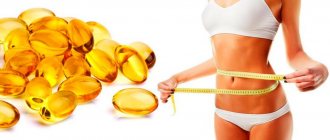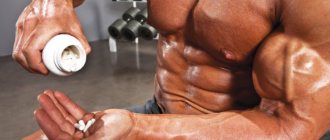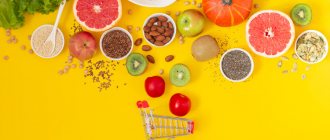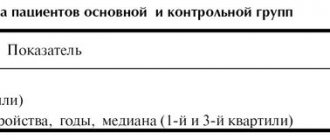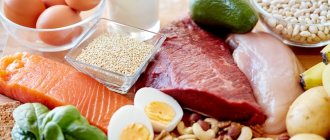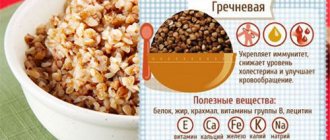Six percent of the total weight of the human body is collagen. This protein, which is a structural protein, is found in every tissue. Collagen forms the human body, gives tissue strength, binds and holds cells. Most of the substances contain ligaments, cartilage, and bones. In bodybuilding, a hydrolyzed form of collagen - gelatin - is often used. It is obtained as a result of heat treatment of animal collagen, which is partially destroyed when exposed to high temperatures. It is completely identical to the anthropogenic one.
Gelatin is used as a thickener in the food industry. Several years ago an attempt was made to pass it off as a protein. Such a strategy could only work for beginners, since experienced athletes know that collagen has an inferior amino acid composition, which is not suitable for building muscle groups. However, gelatin strengthens joints and ligaments well. Many athletes, especially beginners, purchase expensive collagen courses. They don't even suspect that taking regular gelatin has a similar effect. This was the reason for the popularization of gelatin among bodybuilders.
Hydrolyzed collagen[edit | edit code]
Collagen threads under a microscope
Collagen
- This is one of the most common proteins in the human body, its mass fraction is 6% of body weight. Collagen is present in almost all tissues of the body, it is the main structural protein that forms our body and provides strength to tissues, in fact it holds or binds cells together.
Most collagen is found in connective tissues that perform mechanical functions: bones, cartilage and ligaments. There are three types of collagen, each of which is present predominantly in a particular tissue. Thus, joint cartilage mainly contains type II; it is this type of collagen that is available in tablets for oral administration. Types I and III are found in ligaments and bones.
Supplements in capsules or food gelatin?[edit | edit code]
Edible gelatin
Many people don’t even realize that gelatin is hydrolyzed collagen
. Gelatin is obtained by partial destruction of animal collagen using heat treatment (long-term cooking), and in their biological properties they are practically no different, since the latter is destroyed in the same way to oligopeptides in the gastrointestinal tract. Gelatin is used in the food industry as a thickener; previously they even tried to sell this food additive as protein for athletes, but collagen is of little use for building muscle tissue because it has an inferior amino acid composition. Despite this, gelatin can be used as a means to strengthen joints and ligaments. Thus, instead of a course of collagen in tablets or capsules for a thousand or more rubles, you can take regular food gelatin in equivalent doses, and you will get exactly the same therapeutic effect[1], saving your money wisely.
Amino acid composition of gelatin:
[2]
- 22-35% glycine
- 12-21% proline
- 12-15% hydroxyproline
- 10% glutamine
- 9% alanine
- 8% arginine
- 10-27% other amino acids
Effect on the body[edit | edit code]
Gelatin or collagen (Boris Tsatsouline)
Hydrolyzed collagen, or gelatin, is well absorbed from the digestive tract. While studying the absorption of this substance, scientists discovered an interesting fact: part of the collagen is absorbed in the form of oligopeptides (chains of amino acids), which can enter the blood.[3]
Other studies have shown that collagen, taken orally, can restore cartilage integrity, strengthen ligaments, and relieve joint pain.[4][5][6] An increase in the density of collagen fibers and fibroblasts has been found in the skin, cartilage and ligaments[7] (fibroblasts are the cells that produce collagen within the body). Scientists find an explanation for these effects in the fact that collagen can be partially absorbed in the form of oligopeptides, as mentioned above. These oligopeptides have a stimulating effect on connective tissue fibroblasts, actually causing them to work harder and also actively divide.[8]
Gelatin at a dose of 5 g per day for 6 weeks can significantly improve skin properties: elasticity and smoothness.[9]
Recent trials have revealed another positive effect: strengthening bones due to the activating effect on osteoblasts.[10]
Proven beneficial effects of collagen:
- Strengthening cartilage
- Strengthening ligaments
- Strengthening Bones
- Improved muscle nutrition (amino acids are used to build muscle tissue, and the relatively high content of arginine (8%) helps improve blood flow in the muscles).
- Improving skin properties
Indications for taking gelatin
It is recommended to take gelatin for joint pain and include it in your diet as a preventive measure:
- for those who love active recreation and intense sports;
- those who have been diagnosed with arthrosis of the joints, or have been identified as having a predisposition to its occurrence;
- persons living in difficult environmental and climatic conditions, such as the Far North or a large metropolis;
- vegetarians who lack animal components, especially proteins;
- for those who face constant changes in temperature and time zones.
The following technique is also shown:
- Children, as it promotes the formation of healthy joints, their development and growth. Due to a lack of components that form the spine, children often suffer from scoliosis. To normalize the condition, you can use a posture corrector, and you can even prevent the appearance of curvatures.
- It will help middle-aged people cope with increased stress, help cope with tissue degeneration, and maintain joint mobility and health.
- It will help the elderly cope with age-related changes and prevent ossification and wear of tissues. The deformation process slows down.
Doses and recommendations for use[edit | edit code]
In bodybuilding and powerlifting, to strengthen bones, ligaments and joints, collagen in tablets or gelatin is recommended to be taken in a dose of 10 g per day, in 1 or 2 doses in dry form, washed down with water, dissolved in water or made into jelly.[11] The supplement is absolutely safe and is of completely natural origin (made from animal bones and cartilage through prolonged cooking and subsequent destruction by enzymes or acids).
To increase the effectiveness of the course, it is recommended to combine it with chondroitin sulfate and glucosamine sulfate. Or use in conjunction with other supplements for ligaments and joints. And plenty of vitamin C.
Not everyone digests edible gelatin equally well. Excess gelatin can cause many problems, among which the most harmless is an increase in blood clotting.
People who are predisposed to thrombosis and thrombophlebitis, as well as those who suffer from urolithiasis and cholelithiasis, should not abuse products containing gelatin, as they can provoke an exacerbation of the disease.
It is also important to remember that gelatin tinctures, which are used to treat joint diseases, can lead to constipation, inflammation of hemorrhoids, and problems with the gastrointestinal tract.
Also, people suffering from cardiovascular diseases and oxaluric diathesis should consume gelatin only after consulting a doctor, since the increased oxalogen content in this product can cause an exacerbation of these diseases.
In addition, there are known cases of allergies after eating products with gelatin.
Contraindications
Hydrolyzed collagen has few restrictions on its use:
- High blood clotting.
- Vascular pathologies.
- GSD and ICD.
- Problems with the digestive system.
- Haemorrhoids.
- Individual intolerance.
- Sensitization with gelatin.
- Gout.
- CKD.
- Exchange disorders.
To prevent intestinal problems, it is recommended to combine gelatin intake with natural laxatives: prunes, beets, kefir, dried apricots. Senna is also useful.
Recipe: 200 g of natural laxatives are mixed with 50 g of herbs, brewed with a liter of boiling water and infused. Drink a chilled teaspoon at night. Store in a glass container in the refrigerator. The product can be frozen if placed in a plastic container.
Literature[edit | edit code]
- Pearson, David. "Gelatin found to reduce joint pain in athletes"
- https://raypeat.com/articles/articles/gelatin.shtml
- wai, K.; Hasegawa, T., Taguchi, Y., Morimatsu, F., Sato, K., Nakamura, Y., Higashi, A., Kido, Y., Nakabo, Y. and Ohtsuki, K. (2005). "Identification of food-derived collagen peptides in human blood after oral ingestion of gelatin hydrolysates." Journal of agriculture and food chemistry 53 (16): 6531–6536.
- Barnett ML, Kremer JM, St Clair EW, Clegg DO, Furst D, Weisman M, Fletcher MJ, Chasan-Taber S, Finger E, Morales A, Le CH, Trentham DE: Treatment of rheumatoid arthritis with oral type II collagen. Results of a multicenter, double-blind, placebo-controlled trial. Arthritis Rheum 1998 Feb;41(2):290-7.
- Ausar SF, Beltramo DM, Castagna LF, Quintana S, Silvera E, Kalayan G, Revigliano M, Landa CA, Bianco ID: Treatment of rheumatoid arthritis by oral administration of bovine tracheal type II collagen. Rheumatol Int. 2001 May;20(4):138-44.
- Bagchi D, Misner B, Bagchi M, Kothari SC, Downs BW, Fafard RD, Preuss HG: Effects of orally administered undenatured type II collagen against arthritic inflammatory disease: a mechanistic exploration. Int J Clin Pharmacol Res. 2002;22(3-4):101-10.
- Matsuda, N.; Koyama, Y., Hosaka, Y., Ueda, H., Watanabe, T., Araya, T., Irie, S. and Takehana K. (2006). "Effects of ingestion of collagen peptide on collagen fibrils and glycosaminoglycans in the dermis." Journal of nutritional vitaminology 52: 211–215.
- Shigemura, Y.; K Iwai, F Morimatsu, T Iwamoto, T Mori, C Oda, T Taira, EY Park, Y Nakamura and K Sato (2009). "Effect of prolyl-hydroxyproline (Pro-Hyp), a food-derived collagen peptide in human blood, on growth of fibroblasts from mouse skin." J Agric Food Chem 57(2):444–449.
- Matsumoto, H.; Ohara, H., Ito, K., Nakamura, Y. and Takahashi, S. (2006). "Clinical effects of fish type I collagen hydrolysate on skin properties." ITE Letters 7(4): 386–390.
- Nomura, Y.; Oohashi, K., Watanabe, M. and Kasugai (2005). "Increase in bone mineral density through oral administration of shark gelatin to ovariectomized rats." S Nutrition 21(11-12):1120–1126.
- Moskowitz, R. (2000). "Role of collagen hydrolysate in bone and joint disease". Seminars in arthritis and rheumatism 30 (2): 87–99.
For what diseases is gelatin recommended?
Indications for use are the primary stages of diseases of the musculoskeletal system. Advanced forms are difficult to treat with medications, so consulting a doctor is mandatory. The use of the product is recommended for the following diseases:
- osteoporosis;
- age-related changes in connective tissues;
- arthrosis, arthritis;
- necessity and treatment after injuries;
- diseases of the spine;
- weightlifters take the drug to prevent sprains during intense training.
Possible harm
The only known side effects from gelatin are burping, bloating, and indigestion. But even these reactions occur quite rarely. There was a period when gelatin was considered a potentially harmful substance. It was believed that humans could become infected with animal diseases, such as mad cow disease. But these assumptions have never been confirmed by science.
Another danger is taking gelatin as a dietary supplement for too long. It can cause excessive blood viscosity and high blood pressure.
Treatment of joints with gelatin: home recipes with photos
Edible gelatin for joint diseases can be consumed orally or compresses and applications applied to the affected joints to relieve pain and reduce the inflammatory process. Below are the most common recipes for gelatin tinctures and compresses.
Tinctures
Tincture on water
For the healing course you will need to stock up on 150 g of gelatin. You can buy several bags, or you can buy one, but a large one.
Take 2 tsp. gelatin and half a glass (100 ml) of clean water. In the evening, pour gelatin with water and do nothing until the morning. By morning the mixture will have time to swell. It will need to be heated, but should not boil. Bring the total volume of the tincture to a full glass. Add a spoonful of honey or tablet sweetener.
Take orally before meals for a maximum of two weeks. Prepare the tincture every two days.
Gelatin-honey tincture
Take a glass of boiled water and 1 tsp. edible gelatin and liquid honey.
In the evening, dissolve gelatin powder in half a glass of slightly warm water and leave overnight. In the morning before breakfast, heat the container with the mixture (but do not boil) so that the lumps dissolve completely. Add another half glass of water, mix and cool to 40°. Add a spoonful of honey to the tincture.
Use the tincture on an empty stomach for 2 weeks at intervals of three days.
Compresses
You will need:
- gelatin in crystals - 0.5 sachets or whole if a large area is affected;
- gauze or bandage (necessarily clean);
- warm water;
- plastic film or regular cellophane bag;
- something warm - a scarf or scarf.
How to prepare a warm compress:
- Fold gauze or bandage into several layers and dip in warm water, then squeeze lightly.
- Pour gelatin between the layers of material and wrap the affected joint so that the gelatin bandage covers the entire painful area.
- Cover the top of the bandage with polyethylene and bandage it. Wrap a scarf or scarf on top, securing it. Make sure that the limb is free and that the bandage does not compress it too much.
- This warm compress should be applied twice a week and left on the sore joints for 2 hours. It is recommended to make 7 compresses, after which there should be a monthly interval.
The benefits of jelly - myth or reality
Jelly contains protein - collagen. Collagen is the main component of ligaments, tendons and cartilage. With a lack of collagen, the joint quickly wears out and degenerative diseases appear.
Gelatin is not a panacea for joint diseases. It serves as a preventive measure.
Why does collagen deficiency occur?
- for injuries;
- with poor nutrition;
- for metabolic disorders (obesity, dystrophy, endocrine diseases);
- during heavy physical activity;
- with insufficient water consumption;
- in case of poor ecology;
- for hereditary joint diseases;
- As we age, collagen production decreases.
Doctors recommend that everyone who is at risk include gelatin dishes in their diet. This useful product is a source of collagen and slows down the destruction of cartilage. The collagen contained in gelatin helps ligaments stay strong and support the joint. Reliable support for ligaments, muscles and tendons is the prevention of joint diseases.
Jelly will not help with serious joint diseases (arthrosis 2 - 4 degrees). But this product can slow down aging and joint destruction.
The nutritional value
From a nutritional composition perspective, gelatin is a source of certain minerals, vitamins and organic compounds, including copper, calcium, and phosphorus. But the main substance that a person gets from gelatin is protein.
Proteins make up approximately 98% of the total mass of the product.
Meanwhile, this powder does not contain the entire complex of amino acids, which means it cannot serve as a source of complete protein.
However, it has many other delicious properties. Nutritional value per 100 g of product
| Calorie content | 355 kcal |
| Squirrels | 87 g |
| Fats | 0.5 g |
| Carbohydrates | 0.6 g |
| Ash | 1.7 g |
| Potassium | 1 mg |
| Calcium | 700 mg |
| Magnesium | 80 mg |
| Sodium | 11 mg |
| Phosphorus | 300 mg |
| Iron | 2 mg |
| Manganese | 0.1 mg |
| Copper | 1.58 mg |
Essential amino acids in gelatin (per 100 g)
| Leucine | 2.6 g |
| Isoleucine | 1.1 g |
| Valin | 2 g |
| Lysine | 3.5 g |
| Threonine | 1.5 g |
| Methionine | 0.6 g |
| Phenylalanine | 2 g |
Essential amino acids (per 100 g of product)
| Arginine | 6.6 g |
| Histidine | 0.7 g |
| Glycine | 19 g |
| Aspartic acid | 5.3 g |
| Glutamic acid | 8.8 g |
| Alanin | 8 g |
| Proline | 12.2 g |
| Serin | 2.6 g |
